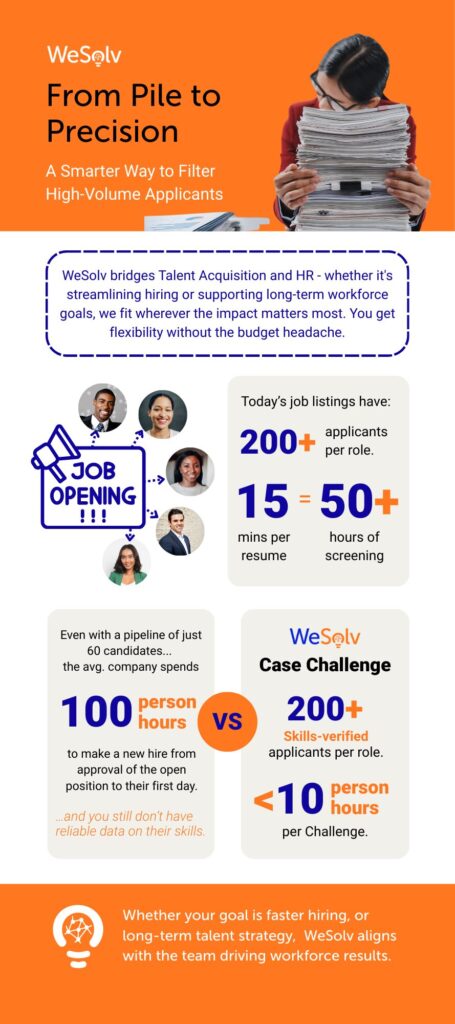Imagine you’re a hiring manager today. You’ve got 237 applications for a single role in the first few days of posting. You’re toggling between an ATS system, a resume parser, a new AI-powered screening tool everyone says will “change everything,” and a handful of spreadsheets you made yourself just to keep up. Despite all the technology, you’re still spending hours trying to figure out which candidates actually have the skills you need – and feeling increasingly overwhelmed and unsure.
You’re not alone. Today’s hiring landscape has made it easy to collect more applicants than ever before — but harder to identify real talent.
That’s why we created this skills-first hiring guide: to help Talent Acquisition and HR leaders cut through the noise and focus on what matters most – proven skills and competencies, not surface-level credentials.
What Is a Skills-First Hiring Strategy — and Why It’s a Game Changer
At its core, a skills-first hiring strategy prioritizes candidates’ real-world abilities over traditional signals like degrees, job titles, or years of experience. Instead of asking, “Where did they work?” or “What school did they attend?” companies ask, “Can they do the work – and do it well?”
This approach isn’t just for technical or coding-heavy roles anymore. While skills assessments have long been standard for engineers and data scientists, leading companies like Salesforce, IBM, and Deloitte are now using skills-first hiring strategies to make leadership hires, too, in areas like Product Management, Operations, and Marketing.
It’s a shift that’s helping organizations:
- Expand and diversify their talent pools
- Reduce bias and increase fairness in hiring
- Hire candidates who can ramp faster and perform better
- Future-proof their workforce by focusing on capabilities that evolve with business needs
If your organization is still relying mainly on resumes and keyword screens, you’re likely missing out on exceptional talent ready to drive real impact. That’s why adopting a skills-first hiring guide is no longer optional – it’s a competitive advantage.
Why a Skills-First Hiring Strategy Beats Traditional Screening (By a Mile)
At its core, a skills-first hiring strategy prioritizes candidates’ real-world capabilities over traditional signals like degrees, job titles, or years of experience. Instead of asking, “Where did they work?” or “What school did they attend?” the focus shifts to a more powerful question: “Can they do the work, and do it well?”
This isn’t just for technical roles like engineering anymore. Forward-thinking companies like Salesforce, IBM, and Deloitte are applying skills-first hiring strategies across leadership, product management, operations, and even customer-facing roles. They recognize that in a rapidly changing economy, proven abilities matter far more than a line item on a resume.
Unfortunately, most companies are still stuck in the old model – skimming resumes, making assumptions about qualifications, and relying heavily on gut feel. And it’s costing them.
According to our recent findings:
- Companies spend an average of 100 person-hours just to make a single hire – even with a small pool of only 60 candidates.
- Even after all that time and effort, they often still lack reliable data about a new hire’s actual skills.
Contrast that with a skills-first approach powered by tools like WeSolv’s Case Challenges:
- You can evaluate 200+ skills-verified applicants per role.
- And it takes less than 10 person-hours total, not 100, to do it.
Each candidate is measured by what they can actually do, not just how they talk about it on paper.
The result? Skills-first hiring offers a dramatically faster, cheaper, and far more reliable process — ensuring that companies hire people who will succeed, not just those who look good on a resume.
That’s why building your own skills-first hiring guide is critical if you want to stay competitive in today’s hiring landscape.
How to Allocate Budget for a Skills-First Hiring Strategy
One of the biggest questions we hear from talent leaders is: Where should I budget for a skills-first hiring initiative?
The short answer: where it will actually remove friction, build evidence, and drive better decisions.
Here’s where a smart investment will pay off — and what to prioritize:
1. Talent Acquisition Team Resources
Why it matters:
TA teams are under intense pressure to fill roles quickly — but without the right tools, they’re trapped in outdated, manual processes. Sifting through resumes, scheduling endless first-round screens, and relying on surface-level information drags down speed and quality.
What to budget for:
Invest in platforms that automate and elevate early screening, such as WeSolv’s Case Challenges. Look for tools that verify skills based on real-world performance, not self-reported resumes, and streamline candidate assessments at scale.
Goal: Free up your recruiters to focus on engaging the best candidates — not just finding them.
2. HR Analytics and Predictive Technology
Why it matters:
Skills-first hiring isn’t just about a better candidate experience, it’s about better business results. But you can’t improve what you don’t measure. Without analytics, it’s impossible to understand your talent pipeline, uncover skills gaps, or predict who will actually succeed in a role.
What to budget for:
Fund technology that supports predictive hiring models, real-time performance analytics, and ongoing skills mapping. Prioritize solutions that integrate with your ATS and deliver actionable insights, not just dashboards.
Goal: Move from reactive hiring to proactive workforce planning, using real data to make smarter bets on talent.
3. Hiring Manager Enablement
Why it matters:
Even the best candidates can be missed, or misjudged, if hiring managers aren’t equipped to evaluate skills effectively. Most are trained to interview, not to assess real work output. That gap creates bias, inefficiency, and costly mis-hires.
What to budget for:
Develop and deliver training programs for hiring managers that teach them how to review case challenge submissions, assess practical skills, and structure final interviews around evidence – not intuition.
Goal: Build a confident hiring manager bench that can consistently identify top performers based on what matters most: what they can actually deliver.
Bottom line:
A skills-first hiring strategy isn’t just a “nice to have” – it’s a competitive edge.
But to make it work, you need to invest in the right areas: talent tools, predictive analytics, and hiring manager enablement.
When you do, you’ll save hundreds of hours, lower your cost-per-hire, and most importantly — hire people who actually drive impact.
Skills-First Hiring Guide: Key Steps to Launch Your Strategy
Here’s a fast-start plan from our skills-first hiring guide to help you put theory into action:
- Define the Core Skills needed for each role (not just years of experience).
- Implement Skills-Based Assessments early in your hiring funnel (like Case Challenges).
- Train Hiring Managers to interpret skills data and work outputs.
- Measure and Iterate using metrics like challenge completion scores, time-to-hire, and first-year performance.
- Communicate to Candidates that you hire based on real ability — this attracts top performers and boosts employer brand.
Or, host a WeSolv Case Challenge and have all of this done for you — from skills identification to candidate evaluation and analytics.

Why Following This Skills-First Hiring Guide Matters
At the end of the day, time is money – but so is bad hiring. If you’re spending 50+ hours screening or 100 person-hours per hire without reliable results, you’re wasting precious resources.
Following a skills-first hiring guide ensures:
- You move from piles of resumes to precision screening.
- You drastically cut time and cost.
- You boost your team’s confidence that they’re hiring proven performers — not just good resume writers.
Whether your focus is faster hiring today or building a workforce strategy for the future, the move to skills-first hiring isn’t just smart — it’s inevitable.

